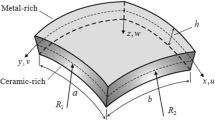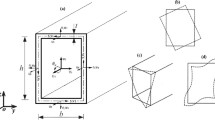Abstract
The elliptic paraboloid failure surface has been well established as a potential criterion for yielding and failure of transversely isotropic materials, presenting also the strength differential effect [1]. This was done by extending well established criteria for isotropic materials presenting the strength differential effect (SDE), through an introduction process which maintained basic physical principles for the anisotropic materials. All previous literature concerned the special case where the principal axes of the external loading coincided with the principal strength axes of the material. In this paper the most general case where the two systems of frames are arbitrarily oriented relatively to each other is considered. In this situation the simplifications derived from the coincidence of the external principal stress and material principal strength axes are lost and the material should be considered as a general orthotropic one. The general properties for such types of loading of the transversely isotropic material are established by maintaining the general features of the failure locus invariant. Then, this study completes the investigation of yielding and failure mode of such materials considering the most general case of their loading.
Similar content being viewed by others
References
Theocaris PS (1986) Failure Criteria for Engineering Materials Based on Anisotropic Hardening. Proc Nat Acad Athens Ser A 61:84–114
Hill, R (1948) A Theory of the Yielding and Plastic Flow of Anisotropic Metals. Proc Roy Soc Lond, Ser A 193:281–297
Von Mises R (1928) Mechanik der plastischen Formänderung von Kristallen, Zeit ang Math und Mech, Vol 8, pp 161–185
Hoffmann O (1967) The Brittle strength of Orthotropic Materials, Jnl Comp Mat, Vol 1, pp. 200–206
Tsai SW, Wu EM (1971) A General Theory of Strength for Anisotropic Materials, Jnl Composite Mat, 5:58–80
Theocaris PS (1987) Generalized Failure Criteria in the Principal Stress Space, Theoret and Appl Mech, Bulgarian Academy of Sciences, Vol 19 (2), pp 74–104
Theocaris PS (1987) Failure Characterization of Anisotropic Materials by Means of the Elliptic Paraboloid Failure Criterion, Uspechi Mechanikii (Advances of Mechanics), vol 10:83–102
Theocaris PS, Philippidis Th (1987) The Paraboloidal Failure Surface of Initially Anisotropic Elastic Solids, Jnl of Reinf Plastics and Comp, Vol 6 (4), pp 378–395
Theocaris PS (1988) Failure Criteria for Transtropic, Pressure Dependent Materials: The Fiber Composites, Rheol Acta, vol 27(5):451–465
Theocaris PS (1988) The Elliptic Paraboloid Failure Surface for 2D-Transtropic Plates (Fiber Laminates). Engng Fract Mech, in press
Narayanaswami R, Adelman HM (1977) Evaluation of the Tensor Polynomial and Hoffman Strength Theories for Composite Materials, Jnl Comp Mat, vol 11:366–377
Theocaris PS (1988) The Paraboloid Failure Surface for the General Orthotropic Material, Acta Mechanica, accepted for publication
Caddell, RM, Woodliff AR (1977) Macroscopic Yielding of Oriented Polymers, Jnl Mat Sci, vol 12:2028–2036
Author information
Authors and Affiliations
Rights and permissions
About this article
Cite this article
Theocaris, P.S. The elliptic paraboloid failure surface for transversely isotropic materials off-axis loaded. Rheol Acta 28, 154–165 (1989). https://doi.org/10.1007/BF01356976
Received:
Issue Date:
DOI: https://doi.org/10.1007/BF01356976




